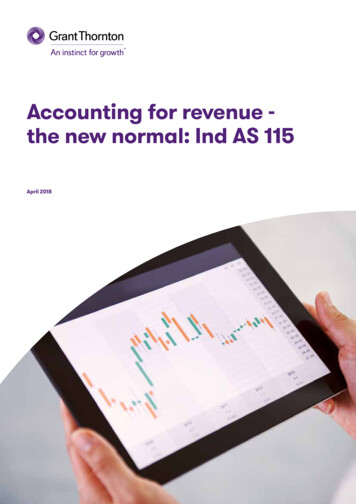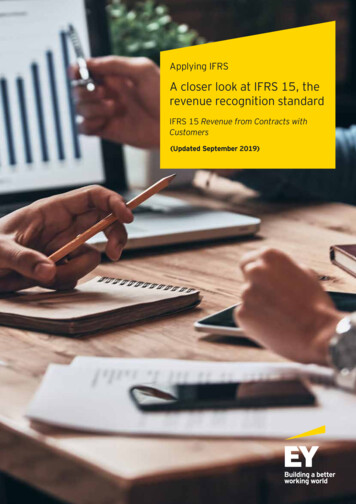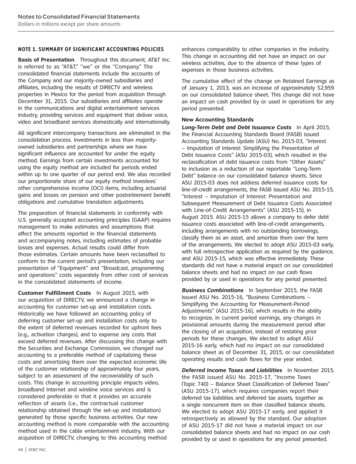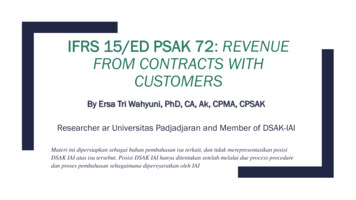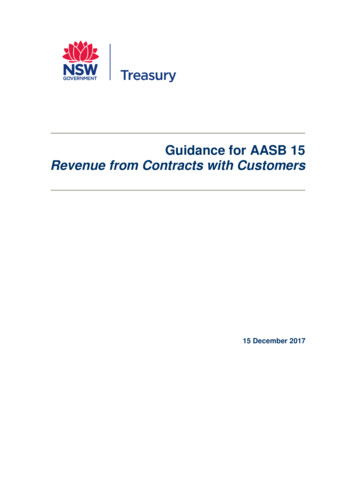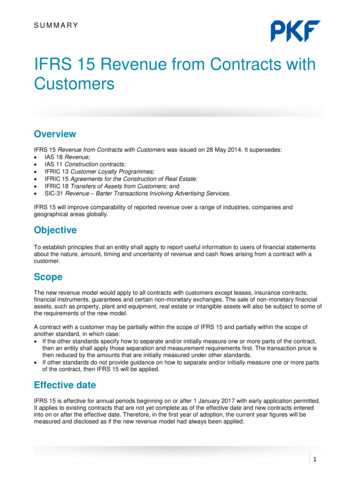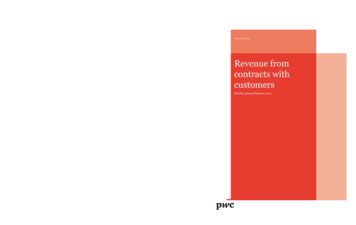
Transcription
www.pwc.comwww.pwc.comRevenue fromcontracts withcustomersPartially updated February 2022Copyright 2016 PricewaterhouseCoopers LLP, a Delaware limited liability partnership. All rights reserved. PwC refers to the Usometimes refer to the PwC network. Each member firm is a separate legal entity. Please see www.pwc.com/structur
About the Revenue fromcontracts with customersguidePwC is pleased to offer our accounting and financial reporting guide for Revenue from contracts withcustomers. This guide summarizes the applicable accounting literature, including relevant referencesto and excerpts from the FASB’s Accounting Standards Codification (the Codification). It also providesour insights and perspectives, interpretative and application guidance, illustrative examples, anddiscussion on emerging practice issues. The PwC guides should be read in conjunction with theapplicable authoritative accounting literature.References to US GAAPDefinitions, full paragraphs, and excerpts from the FASB’s Accounting Standards Codification areclearly designated, either within quotes in the regular text or enclosed within a shaded box. In someinstances, guidance was cited with minor editorial modification to flow in the context of the PwCGuide. The remaining text is PwC’s original content.References to other PwC guidanceThis guide provides general and specific references to chapters in other PwC guides to assist users infinding other relevant information. References to other guides are indicated by the applicable guideabbreviation followed by the specific section number. The other PwC guides referred to in this guide,including their abbreviations, are: Business combinations and noncontrolling interests (BCG) Financial statement presentation (FSP) IFRS and US GAAP: similarities and differences (SD) Leases (LG) Not-for-profit entities (NP) Property, plant, equipment and other assets (PPE) Transfers and servicing of financial assets (TS)Summary of significant changesFollowing is a summary of the noteworthy revisions to the guide since it was last updated. Additionalupdates may be made to future versions to keep pace with significant developments.
About this Revenue from contracts with customers guideRevisions made in February 2022Chapter 3, Identifying performance obligations RR 3.2.3 was added to expand the discussion of stand-ready obligations. RR 3.6.2 was updated to expand the discussion of exclusivity provisions. Figure RR 3-1 was added to RR 3.6.1 to illustrate the assessment of whether activities undertakento fulfill a contract are separate performance obligations.Chapter 8, Practical application issues RR 8.3 was updated to clarify the difference between an assurance-type warranty and aguarantee.Chapter 9, Licenses RR 9.7.1.1 was added to include discussion of a license modification that includes a renewal andother changes.Chapter 10, Principal versus agent considerations Question RR 10-3 was added to RR 10.4 to address the income statement classification ofshipping and handling costs.CopyrightsThis publication has been prepared for general informational purposes, and does not constituteprofessional advice on facts and circumstances specific to any person or entity. You should not actupon the information contained in this publication without obtaining specific professional advice. Norepresentation or warranty (express or implied) is given as to the accuracy or completeness of theinformation contained in this publication. The information contained in this publication was notintended or written to be used, and cannot be used, for purposes of avoiding penalties or sanctionsimposed by any government or other regulatory body. PricewaterhouseCoopers LLP, its members,employees, and agents shall not be responsible for any loss sustained by any person or entity thatrelies on the information contained in this publication. Certain aspects of this publication may besuperseded as new guidance or interpretations emerge. Financial statement preparers and other usersof this publication are therefore cautioned to stay abreast of and carefully evaluate subsequentauthoritative and interpretative guidance.The FASB Accounting Standards Codification material is copyrighted by the Financial AccountingFoundation, 401 Merritt 7, Norwalk, CT 06856, and is reproduced with permission.
Chapter 1:An introduction to revenuefrom contracts withcustomers—updated February20221-1
An introduction to revenue from contracts with customers1.1Background on the revenue standardRevenue is one of the most important financial statement measures to both preparers and users offinancial statements. It is used to measure and assess aspects of a reporting entity’s past financialperformance, future prospects, and financial health. Revenue recognition is therefore one of theaccounting topics most scrutinized by investors and regulators. Despite its significance and theincreasing globalization of the world’s financial markets, revenue recognition requirements prior toissuance of new guidance in 2014 differed in US generally accepted accounting principles (“US GAAP”)from those in International Financial Reporting Standards (“IFRS”), at times resulting in differentaccounting for similar transactions.The Financial Accounting Standards Board (“FASB”) and the International Accounting StandardsBoard (“IASB”) (collectively, the “boards”) jointly developed a standard containing comprehensiveprinciples for recognizing revenue. As a result, the FASB issued ASC 606, Revenue from Contractswith Customers, and ASC 340-40, Other Assets and Deferred Costs—Contracts with Customers(collectively, the “revenue standard”), and the IASB issued IFRS 15, Revenue from Contracts withCustomers, in May 2014 along with consequential amendments to existing standards. With theexception of a few discrete areas, the revenue standards are converged, eliminating most previousdifferences between US GAAP and IFRS in accounting for revenue from contracts with customers.The boards subsequently issued multiple amendments to the new revenue standards as a result offeedback from stakeholders, primarily related to: Deferral of the effective date of the revenue standard Collectibility (see RR 2.6.1.5) Identification of performance obligations (see RR 3.3) Noncash consideration (see RR 4.5) Licenses of intellectual property (see RR 9) Principal versus agent guidance (see RR 10) Practical expedients at transitionThe amendments made by the FASB and IASB are not identical. For certain of the amendments, thefinancial reporting outcomes will be similar despite the use of different wording in ASC 606 and IFRS15. However, there may be instances where differences in the guidance result in different conclusionsunder US GAAP and IFRS. Refer to SD 3.1 through SD 3.11 for further discussion of similarities anddifferences between the US GAAP and IFRS revenue standards.1.1.1Revenue recognition transition resource groupIn connection with the issuance of the revenue standards, the boards established a joint workinggroup, the Revenue Recognition Transition Resource Group (TRG), to seek feedback on potentialimplementation issues. The TRG met through 2016 and did not issue authoritative guidance butassisted the boards in determining whether they needed to take additional action, which could includeamending the guidance. The TRG comprised financial statement preparers from a wide spectrum of1-2
An introduction to revenue from contracts with customersindustries, auditors, users from various geographical locations, and public and private organizations.Replays and minutes of the TRG meetings are available on the TRG pages of the FASB’s website.Discussions of the TRG are nonauthoritative, but management should consider those discussions asthey may provide helpful insight into that way the guidance might be applied in similar facts andcircumstances. The SEC staff, for example, has indicated that it would use the TRG discussion as abasis to assess the appropriateness of SEC registrants’ revenue recognition policies.Figure RR 1-1 lists the issues discussed by the TRG with the reference to the related TRG paper. Theminutes of those discussions are recorded in separate TRG papers, the reference to which is alsoincluded in the table.Figure RR 1-1Issues discussed by the TRGDatediscussedTRGpaperreferenceTRG minutespaper referenceTopic discussedRevenue guidereferenceJuly 18, 201415Gross versus netrevenue*RR 10July 18, 201425Gross versus netrevenue: amountsbilled to customers*RR 10July 18, 201435Sales-based andusage-basedroyalties in contractswith licenses andgoods or servicesother than licenses*RR 9.8July 18, 201445Impairment testingof capitalizedcontract costs*RR 11.4.2October 31, 2014611Customer optionsfor additional goodsand services andnonrefundableupfront feesRR 7.2October 31, 2014711Presentation of acontract as acontract asset or acontract liabilityFSP 33.3October 31, 2014811Determining thenature of a license ofintellectualproperty*RR 9.51-3
An introduction to revenue from contracts with customersDatediscussedTRGpaperreferenceTRG minutespaper referenceTopic discussedRevenue guidereferenceOctober 31, 2014911Distinct in thecontext of thecontract*RR 3.4October 31, 20141011Contractenforceability andtermination clausesRR 2.6 and RR 2.7January 26,20151225Identifyingpromised goods orservices*RR 3.2January 26,20151325Collectibility*RR 2.6.1.5 and RR2.6.3January 26,20151425VariableconsiderationRR 4.3.2 and RR5.5January 26,20151525Noncashconsideration*RR 7.2.6January 26,20151625Stand-readyobligationsRR 6.4.3January 26,20151725Islamic financetransactionsRR 2.2January 26,20152325Costs to obtain acontractRR 11.2January 26,20152425Contractmodifications*RR 2.9March 30, 20152634Contributions*RR 2.2.1March 30, 20152734Series of distinctgoods or servicesRR 3.3.2March 30, 20152834Considerationpayable to acustomerRR 4.6March 30, 20152934WarrantiesRR 8.3March 30, 20153034Significant financingcomponentRR 4.4March 30, 20153134Variable discountsRR 4.3 and RR5.5.11-4
An introduction to revenue from contracts with customersDatediscussedTRGpaperreferenceTRG minutespaper referenceTopic discussedRevenue guidereferenceMarch 30, 20153234Exercise of amaterial rightRR 7.2.2, RR 7.2.4,and RR 8.4.1March 30, 20153334Partially satisfiedperformanceobligationsRR 2.6.2 and RR6.4.6July 13, 20153544Accounting forrestocking fees andrelated costsRR 8.2.2July 13, 20153644Credit cardsRR 2.2July 13, 20153744Considerationpayable to acustomerRR 4.6July 13, 20153844Portfolio practicalexpedient andapplication ofvariableconsiderationRR 4.3.1.1July 13, 20153944Application of theseries provision andallocation of variableconsiderationRR 3.3.2, RR4.3.3.6 and RR5.5.1July 13, 20154044Practical expedientfor measuringprogress towardcompletesatisfaction of aperformanceobligationRR 6.4.1.1July 13, 20154144Measuring progresswhen multiple goodsor services areincluded in a singleperformanceobligationRR 6.4.5July 13, 20154244Completed contractsat transition*July 13, 20154344Determining whencontrol of acommodity transfersRR 6.3.11-5
An introduction to revenue from contracts with customersDatediscussedTRGpaperreferenceTRG minutespaper referenceTopic discussedRevenue guidereferenceNovember 9,20154549Licenses — Specificapplication issuesabout restrictionsand renewals*RR 9.6 and RR 9.7November 9,20154649Pre-productionactivities*RR 3.6.1 and RR11.3.3November 9,20154749Whether fixed oddswagering contractsare included orexcided from thescope of Topic 606*RR 2.2November 9,20154849Customer optionsfor additional goodsand servicesRR 2.7, RR 3.5, andRR 7April 18, 2016(US only)5055Scopingconsiderations forincentive-basedcapital allocationsN/AApril 18, 2016(US only)5155Contract assettreatment incontractmodificationsRR 2.9.3.1April 18, 2016(US only)5255Scopingconsiderations forfinancial institutionsRR 2.2April 18, 2016(US only)5355Evaluating howcontrol transfersover timeRR 6.3 and RR6.4.1April 18, 2016(US only)5455Class of customerRR 7.2November 7,2016(US only)5660November 7,2016(US only)5760Over time revenuerecognitionCapitalization andamortization ofincremental costs ofobtaining a contractRR 6.3.3.2RR 11.2 and RR11.4.11-6
An introduction to revenue from contracts with customersDatediscussedTRGpaperreferenceTRG minutespaper referenceNovember 7,2016(US only)5860November 7,2016(US only)5960Topic discussedSales-based orusage-based royaltywith minimumguaranteePayments tocustomersRevenue guidereferenceRR 9.8RR 4.6*Amendments to one or both standards were as a result of these discussions. Refer to referenced chapters for further discussion.1.2High-level overview of the revenue standardRevenue is defined in the revenue standard as:Definition from ASC 606-10-20Revenue: Inflows or other enhancements of assets of an entity or settlements of its liabilities (or acombination of both) from delivering or producing goods, rendering services, or other activities thatconstitute the entity’s ongoing major or central operations.Refer to FSP 33.2.2 for discussion of the distinction between revenue and other types of income, suchas gains.Many revenue transactions are straightforward, but some can be highly complex. For example,software arrangements, licenses of intellectual property, outsourcing contracts, barter transactions,contracts with multiple elements, and contracts with milestone payments can be challenging tounderstand. It might be difficult to determine what the reporting entity has committed to deliver, howmuch and when revenue should be recognized.Contracts often provide strong evidence of the economic substance, as parties to a transactiongenerally protect their interests through the contract. Amendments, side letters, and oral agreements,if any, can provide additional relevant information. Other factors, such as local legal frameworks andbusiness practices, should also be considered to fully understand the economics of the arrangement. Areporting entity should consider the substance, not only the form, of a transaction to determine whenrevenue should be recognized.The revenue standard provides principles that a reporting entity applies to report useful informationabout the amount, timing, and uncertainty of revenue and cash flows arising from its contracts toprovide goods or services to customers. The core principle requires a reporting entity to recognizerevenue to depict the transfer of goods or services to customers in an amount that reflects theconsideration that it expects to be entitled to in exchange for those goods or services.1-7
An introduction to revenue from contracts with customers1.2.1The five-step model for recognizing revenueFigure RR 1-2 illustrates the five-step model the boards developed for recognizing revenue fromcontracts with customers:Figure RR 1-2Five-step modelCertain criteria must be met for a contract to be accounted for using the five-step model in the revenuestandard. A reporting entity must assess, for example, whether it is “probable” it will collect theamounts it will be entitled to before the guidance in the revenue standard is applied.A contract contains a promise (or promises) to transfer goods or services to a customer. A performanceobligation is a promise (or a group of promises) that is distinct, as defined in the revenue standard.Identifying performance obligations can be relatively straightforward, such as an electronics store’spromise to provide a television. But it can also be more complex, such as a contract to provide a newcomputer system with a three-year software license, a right to upgrades, and technical support.Reporting entities must determine whether to account for performance obligations separately, or as agroup.The transaction price is the amount of consideration a reporting entity expects to be entitled to from acustomer in exchange for providing the goods or services. A number of factors should be considered todetermine the transaction price, including whether there is variable consideration, a significantfinancing component, noncash consideration, or amounts payable to the customer.The transaction price is allocated to the separate performance obligations in the contract based onrelative standalone selling prices. Determining the relative standalone selling price can be challengingwhen goods or services are not sold on a standalone basis. The revenue standard sets out severalmethods that can be used to estimate a standalone selling price when one is not directly observable.Allocating discounts and variable consideration must also be considered.Revenue is recognized when (or as) the performance obligations are satisfied. The revenue standardprovides guidance to help determine if a performance obligation is satisfied at a point in time or overtime. Where a performance obligation is satisfied over time, the related revenue is also recognized overtime.1-8
An introduction to revenue from contracts with customers1.2.2Portfolio approach for applying the revenue standardA reporting entity generally applies the model to a single contract with a customer. A portfolioapproach might be acceptable if a reporting entity reasonably expects that the effect of applying aportfolio approach to a group of contracts or group of performance obligations would not differmaterially from considering each contract or performance obligation separately. A reporting entityshould use estimates and assumptions that reflect the size and composition of the portfolio when usinga portfolio approach. Determining when the use of a portfolio approach is appropriate will requirejudgment and a consideration of all of the facts and circumstances.1.3Revenue recognition disclosuresThe revenue standard includes extensive disclosure requirements intended to enable users of financialstatements to understand the amount, timing, risks, and judgments related to revenue recognition andrelated cash flows. The revenue standard requires disclosure of both qualitative and quantitativeinformation about contracts with customers and provides some simplified disclosure options fornonpublic reporting entities as further discussed in FSP 33.5.1-9
Chapter 2:Scope and identifying thecontract—updated February20222-1
Scope and identifying the contract2.1Overview–scope and identifying the contractThe first step in applying the revenue standard is to determine if a contract exists and whether thatcontract is with a customer. This assessment is made on a contract-by-contract basis, although asnoted in RR 1.2.2, as a practical expedient a reporting entity may apply this guidance to a portfolio ofsimilar contracts (or similar performance obligations) if the reporting entity expects that the effects onthe financial statements would not materially differ from applying the guidance to the individualcontracts (or individual performance obligations).Management needs to identify whether the contract counterparty is a customer, since contracts thatare not with customers are outside of the scope of the revenue standard. Management also needs toconsider whether the contract is explicitly scoped out of the revenue standard, or whether there isanother standard that applies to a portion of the contract. Determining whether a contract is in thescope of the revenue standard will not always be straightforward.Management must also consider whether more than one contract with a customer should be combinedand how to account for any subsequent modifications.2.2Scope of the revenue standardManagement needs to consider all other potentially relevant accounting literature before concludingthat the arrangement is in the scope of the revenue standard. Arrangements that are entirely in thescope of other guidance should be accounted for under that guidance. Arrangements may includeelements that are partly in the scope of other standards and partly in the scope of the revenuestandard. The elements that are accounted for under other standards are separated and accounted forunder those standards, as illustrated in Figure RR 2-1 and discussed in RR 2.2.3.2-2
Scope and identifying the contractFigure RR 2-1Accounting for contracts partially in scope of the revenue standardThere are no industries completely excluded from the scope of the revenue standard; however, thestandard specifically excludes from its scope certain types of transactions: Leases in the scope of ASC 840, Leases [ASC 842, Leases, upon adoption] Contracts in the scope of ASC 944, Financial Services—Insurance Financial instruments and other contractual rights or obligations in the scope of the followingguidance:oASC 310, Receivables; ASC 320, Investments—Debt and Equity Securities; ASC 323,Investments—Equity Method and Joint Ventures; ASC 325, Investments—Other; ASC 405,Liabilities; ASC 470, Debt; ASC 815, Derivatives and Hedging; ASC 825, FinancialInstruments; and ASC 860, Transfers and Servicing Nonmonetary exchanges between reporting entities in the same line of business to facilitate salesto current or future customers Guarantees (other than product or service warranties—see RR 8 for further considerations relatedto warranties) in the scope of ASC 460, GuaranteesArrangements should be assessed to determine whether they are within the scope of other guidanceand, therefore, outside the scope of the revenue standard. Refer to Revenue TRG Memo No. 17,Revenue TRG Memo No. 36, Revenue TRG Memo No. 47, US Revenue TRG Memo No. 52, and therelated meeting minutes in Revenue TRG Memo No. 25, Revenue TRG Memo No. 44, Revenue TRGMemo No. 49, and Revenue TRG Memo No, 55, respectively, for further discussion of scoping issues2-3
Scope and identifying the contractdiscussed by the TRG. Following are examples of how to apply the scoping guidance to specific types oftransactions. Credit card feesCredit card fees are outside the scope of the revenue standard for reporting entities, unless theoverall nature of the arrangement is not a credit card lending arrangement. Credit card fees areaddressed by specific guidance in ASC 310, Receivables. If a credit card arrangement isdetermined to be outside the scope of the revenue standard, any related reward program is alsooutside the scope. Management should evaluate the nature of the reporting entity’s credit cardprograms to assess whether they are in the scope of ASC 310 and continue to evaluate newprograms as they evolve. Refer to Revenue TRG Memo No. 36 and the related meeting minutes inRevenue TRG Memo No. 44 for further discussion of this topic. Depository account feesWhen a customer deposits funds at a bank, the customer and the bank enter into a depositoryagreement that provides the customer with certain services, such as custody of deposited fundsand access to those deposited funds. The bank may charge the customer fees for accessing thefunds, not maintaining a specified minimum account balance, or not utilizing the account. Thesefees are not within the scope of other specific guidance and, therefore, are within the scope of therevenue standard. Refer to Revenue TRG Memo No. 52 and the related meeting minutes inRevenue TRG Memo No. 55 for further discussion of this topic. These TRG memos also includediscussion of the application of the revenue standard to deposit fees, including determining thecontract term when the arrangement can be terminated without significant penalty and theaccounting implications of no-fee or reduced-fee arrangements. Servicing feesServicing arrangements are those in which fees are earned when a reporting entity providesservicing (of a mortgage or other financial assets) on behalf of another party that owns the loan orother assets. When a reporting entity records a servicing right as an asset (or a liability), the initialand subsequent recognition of the asset (or liability) is subject to the guidance in ASC 860. WhileASC 860 provides guidance on the subsequent accounting for servicing rights, it does notprescribe how the servicing revenue should be recognized. Servicing arrangements within thescope of ASC 860 would not be subject to the revenue standard even though ASC 860 does notprescribe how servicing revenue should be recognized. However, if a reporting entity concludesthat its servicing arrangements are not subject to ASC 860, they would be subject to the revenuestandard. Refer to Revenue TRG Memo No. 52 and the related meeting minutes in Revenue TRGMemo No. 55 for further discussion of this topic. Refer to TS 6 for further discussion of accountingfor servicing arrangements under ASC 860. Gaming contractsFixed-odds wagering contracts, including any associated loyalty programs, within the scope of ASC924, Entertainment — Casinos, are excluded from the scope of the derivative instrumentsguidance (ASC 815) and, thus, are within the scope of the revenue standard.Refer to Revenue TRG Memo No. 47 and the related meeting minutes in Revenue TRG Memo No.49 for further discussion of this topic.2-4
Scope and identifying the contract InsuranceAll contracts in the scope of ASC 944 are excluded from the revenue standard. This includes lifeinsurance, health insurance, property and casualty insurance, title insurance, mortgage guaranteeinsurance, and investment contracts. The scope exception does not apply to other types ofcontracts that may be issued by insurance reporting entities that are outside the scope of insuranceguidance, such as asset management and claims handling (administrative services) contracts.Contracts could also be partially within the scope of the insurance guidance and partially withinthe scope of the revenue standard. Management may need to apply judgment to make thisdetermination. If a contract is entirely in the scope of the insurance guidance, activities to fulfillthe contract, such as insurance risk mitigation or cost containment activities, should be accountedfor under the insurance guidance.2.2.1Revenue that does not arise from a contract with a customerRevenue from transactions or events that does not arise from a contract with a customer is not in thescope of the revenue standard and should continue to be recognized in accordance with otherstandards. Such transactions or events include but are not limited to:2.2.2 Dividends Non-exchange transactions, such as donations or contributions. For example, contributionsreceived by a not-for-profit reporting entity are not within the scope of the revenue standard ifthey are not given in exchange for goods or services (that is, they represent non-exchangetransactions). Refer to Revenue TRG Memo No. 26, the related meeting minutes in Revenue TRGMemo No. 34, and NP 6 for further discussion of this topic. Changes in regulatory assets and liabilities arising from alternative revenue programs for rateregulated activities in the scope of ASC 980, Regulated OperationsEvaluation of nonmonetary exchangesAs noted in RR 2.2, nonmonetary exchanges between reporting entities in the same line of business tofacilitate sales to current or future customers are excluded from the scope of the revenue standard.Reporting entities should assess these arrangements under ASC 845, Nonmonetary Transactions.Refer to PPE 2.3.1 and PPE 6.3.6 for guidance on nonmonetary transactions.Nonmonetary exchanges with customers that are in the scope of the revenue standard are exchangesof goods or services for noncash consideration. Refer to the guidance on noncash consideration in RR4.5.Determining whether nonmonetary exchanges are in the scope of the revenue standard could requirejudgment and depends on the facts and circumstances of the arrangement. Example RR 2-1 illustratesan arrangement that is not within the scope of the revenue standard.2-5
Scope and identifying the contractEXAMPLE RR 2-1Scope — exchange of products to facilitate a sale to another partySalter is a supplier of road salt. Adverse weather events can lead to a sudden increase in demand, andSalter does not always have a sufficient supply of road salt to meet this demand on short notice. Salterenters into a contract with SaltCo, a supplier of road salt in another region, such that each party willprovide road salt to the other during local adverse weather events as they are rarely affected at thesame time. No other consideration is provided by the parties.Is the contract in the scope of the revenue standard?AnalysisNo. This arrangement is not in the scope of the revenue standard because the standard specificallyexcludes from its scope nonmonetary exchanges in the same line of business to facilitate sales tocustomers or potential customers.2.2.3Contracts with components in and out of the scope of revenueSome contracts include components that are in the scope of the revenue standard and othercomponents that are in the scope of other standards. For example, a contract could include a financialguarantee given by the vendor (refer to RR 4.3.3.9 for further discussion of guarantees) or a lease ofproperty, plant, and equipment in addition to a promise to provide goods or services. A reportingentity should first apply the separation or measurement guidance in other applicable standards (ifany) and then apply the guidance in the revenue standard. A reporting entity applies the guidance inthe revenue standard to initially separate and/or measure the components of the contract only ifanother standard does not include separation or measurement guidance. The transaction price, asdescribed in RR 4.2, excludes the portion of contract consideration that is initially measured underother guidance.2.2.3.1Election to combine lease and non-lease componentsReporting entities can elect a practical expedient (provided in ASC 842) that permits lessors tocombine lease and non-lease components within a contract if certain criteria are met. The practicalexpedient applies to contracts that include an operating lease and a non-lease component, such as apromise to provide services. To qualify for the expedient, the pattern of transfer of the operating leaseand the non-lease component must be the same (that is, on a strai
performance, future prospects, and financial health. Revenue recognition is therefore one of the accounting topics most scrutinized by investors and regulators. Despite its significance and the . Revenue guide reference July 18, 2014 1 5 Gross versus net revenue* RR 10 July 18, 2014 2 5 Gross versus net revenue: amounts billed to customers*


